Otoplasty is a simple surgical procedure designed to reshape the ears. This surgery is beneficial for individuals with congenital deformities or those who have experienced accidents that alter the natural shape of one or both ears, leading to embarrassment and a lack of self-confidence.
In general, it is one of the most common plastic surgeries. Otoplasty does not take a long time; it is not complicated, its results are immediate, and it does not require a period to recuperate. A person can typically resume his life immediately after the operation. The table shows some necessary details of the procedure.
| Anesthesia | Full or Local |
| Procedure duration | 1 – 2 Hours |
| Results Appearance | Immediate |
| Continuity of results | Lifetime |
| Convalescence | No need |
| Special Cases | It may require correction of one ear, and the cost is higher when cartilage is needed |
How is Otoplasty Performed?
There are several cases of otoplasty, including:
- Reducing the size while maintaining its ideal shape and appearance.
- Adjusting the position of the ear to be beside the head is called a concave ear in this case.
- There is also a third, somewhat rare condition called bat ear, where the ear is half-closed and directed forward.
The surgical or cosmetic procedure place is hidden, with all incisions and stitches at the back of the ear.
Otoplasty Surgery Video
Who is Eligible for otoplasty?
It is preferable to perform cosmetic surgery for children at an early age, after their growth is complete, which is from the age of six to ten years. Most children who suffer from appearance problems may be negatively affected in their social life and psychological state.
Adults who do not have health problems can also undergo Otoplasty.
To undergo this cosmetic surgery, a person must meet the following conditions:
- Be fully aware of what their appearance will be like after the surgery and not have unrealistic expectations.
- Individuals who suffer from an unacceptable ear appearance.
- They have an abnormal shape in their ears, necessitating the surgery.

Who is Not eligible for Otoplasty?
No absolute contraindications prevent a patient from undergoing ear cosmetic surgery. The patient should inform the doctor of any chronic medical conditions they suffer from, if any, as a precaution and to ensure the doctor is fully aware of the patient’s condition.
Who Performs Otoplasty?
A plastic surgeon and an otolaryngologist perform Otoplasty in a sterile clinical environment in the hospital. Choosing a highly reputable hospital is preferable to ensure the results meet the patient’s expectations.
Anesthesia Types
The type of anesthesia is one of the most essential inquiries for anyone undergoing surgery. In Otoplasty, we will detail two types of anesthesia.
Local Anesthesia
Local anesthesia is administered before the procedure without the need to stay in the hospital after the operation. It is injected into the area of the procedure in the body. Once it takes effect, the patient does not feel any pain during the operation, including minor pain, while remaining awake.
General Anesthesia
General anesthesia is another option for anesthesia used in ear cosmetic surgery. The patient must fast for 8 hours before the procedure to avoid discomfort after the operation. The patient must also stay in the hospital after the procedure in the case of general anesthesia, unlike local anesthesia.
Compared to local anesthesia, the cost of the procedure using general anesthesia is higher. After the anesthesia is injected into the vein, the patient falls asleep immediately and wakes up after the procedure.
Otoplasty Types
The cost and steps of ear cosmetic surgery vary according to the type of deformity. Here are the most common types of surgeries:
Prominent Ear Surgery
The cause of a prominent ear is the excessive growth of ear cartilage, which makes it appear larger than usual and further away from the head, giving it a deformed appearance. It starts to appear after birth, with children being born with normal ears that grow and enlarge in the early years.
Sometimes, both ears grow, and other times, one ear appears more prominent than the other. Of course, there are specific criteria to classify ears as prominent based on the size of the ear and its distance from the head, which calls for a medical intervention to correct this defect according to the decision of the person with the problem and the doctor.

Bat Ear Correction
Bat ear, also known as bat-like ear, refers to ears with a closed and circular pinna. This surgery is considered more complex compared to prominent ear surgery. Age is an essential factor in treating this type of deformity. Medical intervention for children before the age of six is advantageous due to the flexibility of cartilage and the capacity to guide its growth and direction.
Auricle (Pinna) Transplant
Auricle reconstruction or transplant involves implanting an ear pinna, typically in cases where there is no external pinna due to a congenital deformity or an accident. A complex surgery often requires multiple stages, including reconstructive and cosmetic surgeries, to achieve the desired results.
Otoplasty Steps
Like other surgeries, Otoplasty goes through three main stages (before, during, and after). We will discuss them in detail.
Total Time: 2 hours
Before the Process
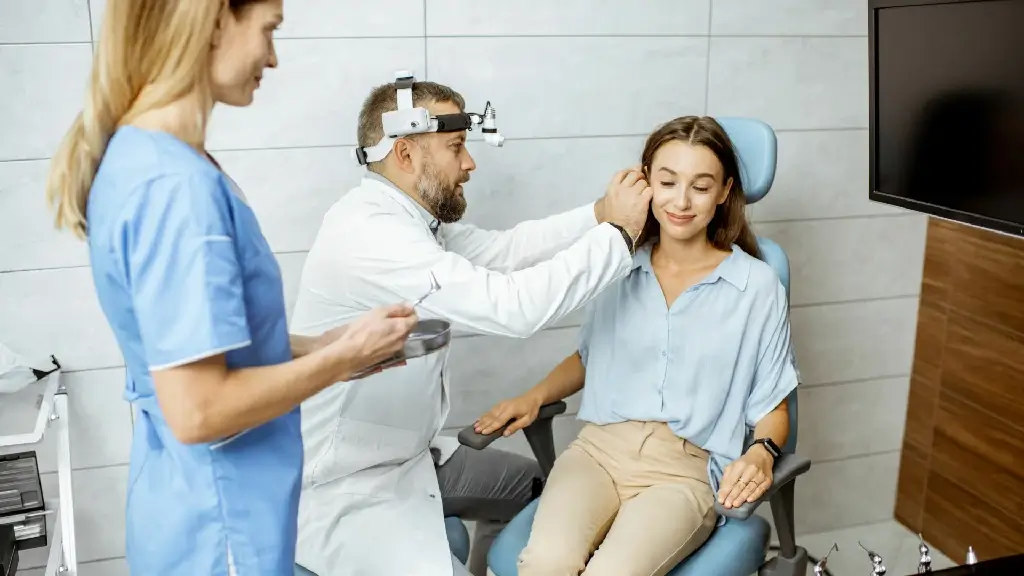
Before the surgery, smoking, alcohol, and blood-thinning medications should be reduced as much as possible. The patient should also inform the doctor about any medications they are using, if any. It is preferable to wear comfortable clothing that can be opened from the front and to refrain from eating and drinking for 8 hours before the procedure in case of general anesthesia.
The patient should arrive at the scheduled time for the cosmetic surgery, follow all instructions, and inform the medical team of anything unusual. The patient undergoes some general tests to ensure no obstacles to the surgery.
During the Process
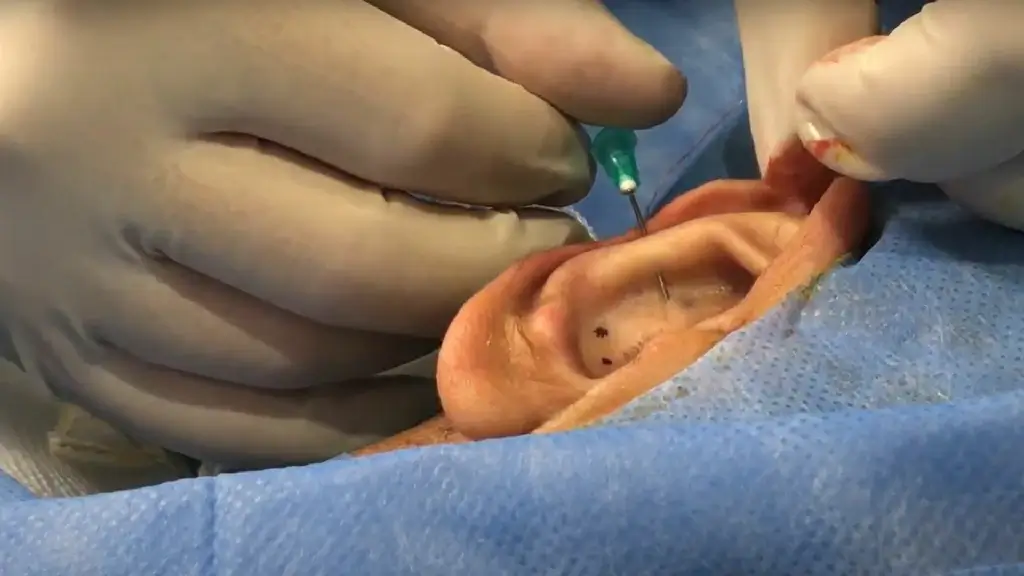
After preparing the operating room, the patient is ready for anesthesia. Depending on each case, the doctor begins the procedure, which takes 1-2 hours.
The patient is anesthetized locally or generally, as the surgeon decides based on the patient’s condition. For children, general anesthesia is often preferred, while for older adults, local anesthesia with sedation is preferred to keep the patient awake but relaxed. The surgery begins with an incision behind the ear, precisely on the natural fold where the ear meets the head. The surgeon removes the cartilage and skin to achieve the desired result. Sometimes, the surgeon trims and reshapes the cartilage using permanent sutures to fix the cartilage in the desired position. At the same time, the ear is fixed in the desired position until the wound heals, ensuring the ear remains in the correct place.
After the Process
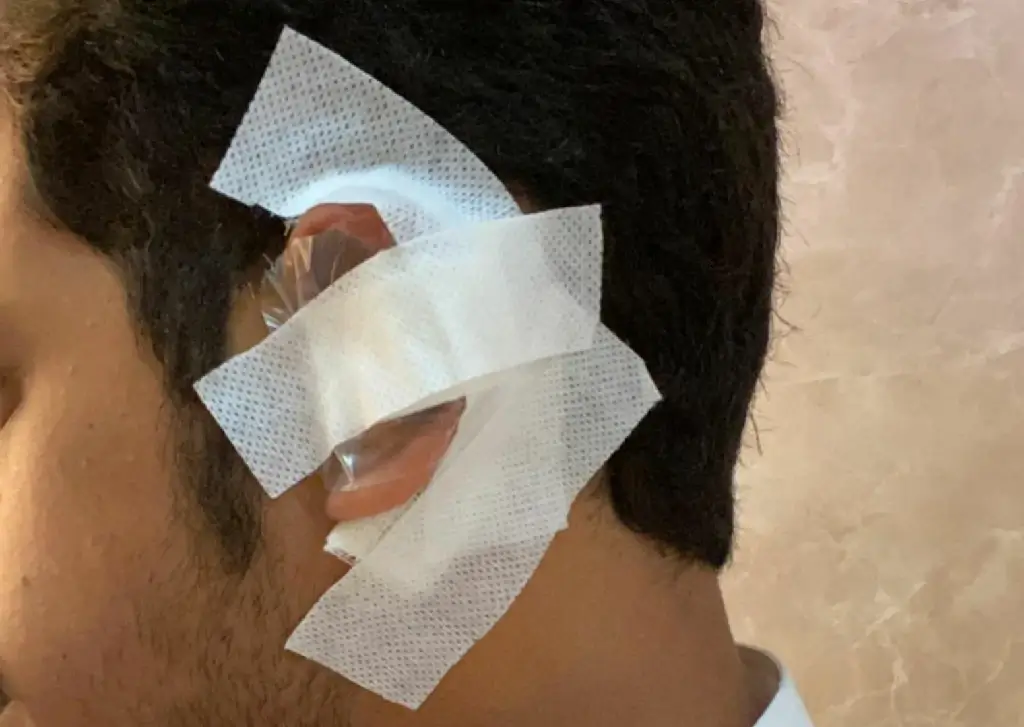
After the procedure, in some cases, a bandage is placed over the ear to ensure it does not move and stays in place during the first day after the surgery. Mild swelling may occur while wearing it. During the first week, patients should avoid touching the ear as much as possible. The patient can resume daily activities generally after the first week of the surgery. One of the most essential aspects in this regard is to be as careful as possible while sleeping, ensuring that the ear does not touch the pillow or sleep on it. Taking precautions during the post-procedure period can minimize side effects, and recovery can be expedited significantly.
Estimated Cost: 1500 EUR
Before and After otoplasty
Otoplasty is very simple. The results can be observed before and immediately after the procedure, as shown in the following pictures of the cases performed at Turk Aesthetic.
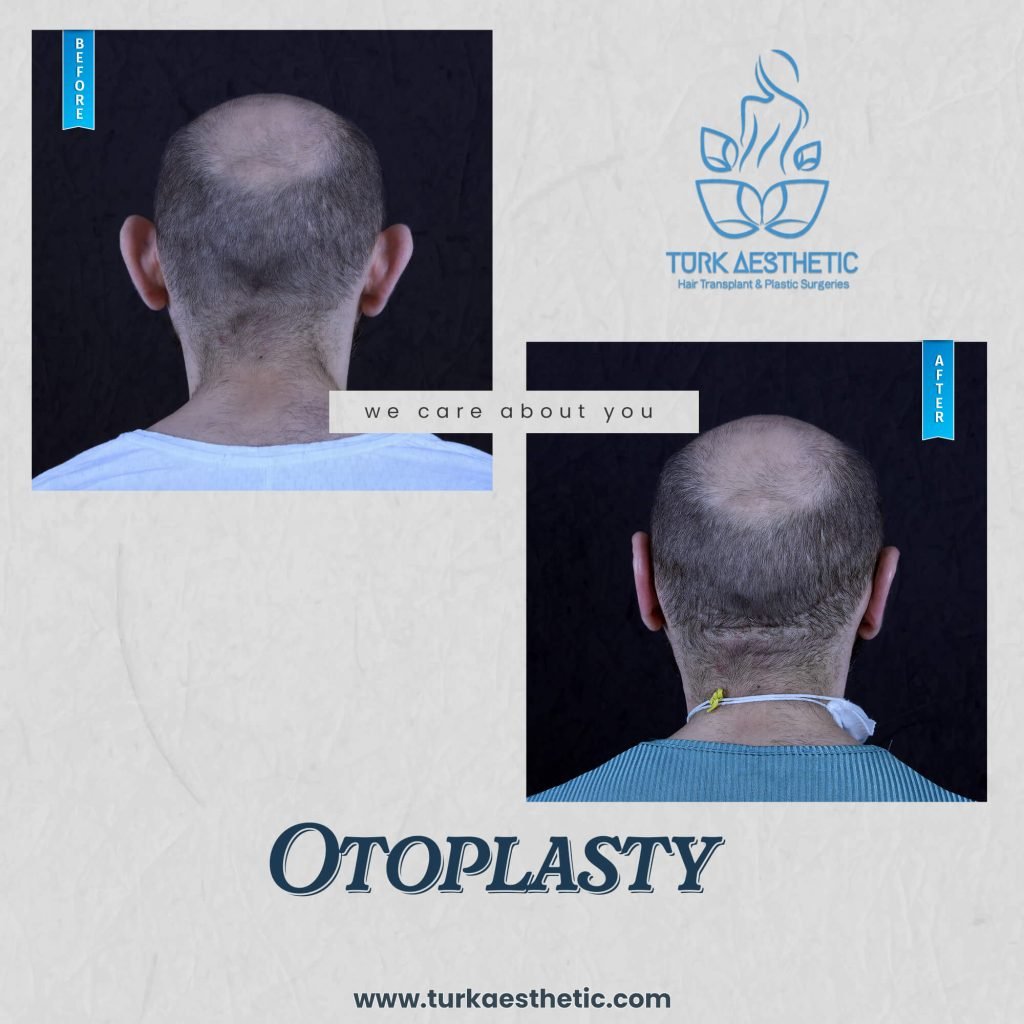
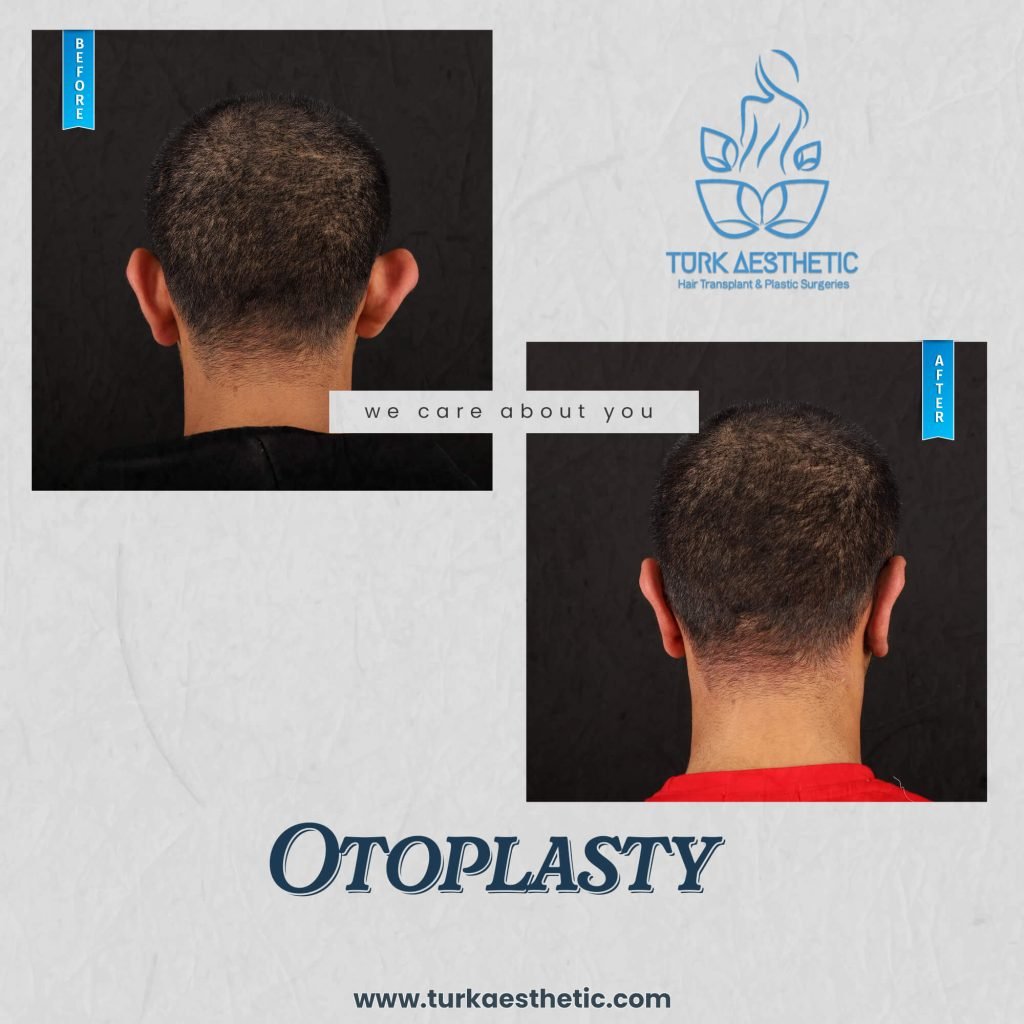
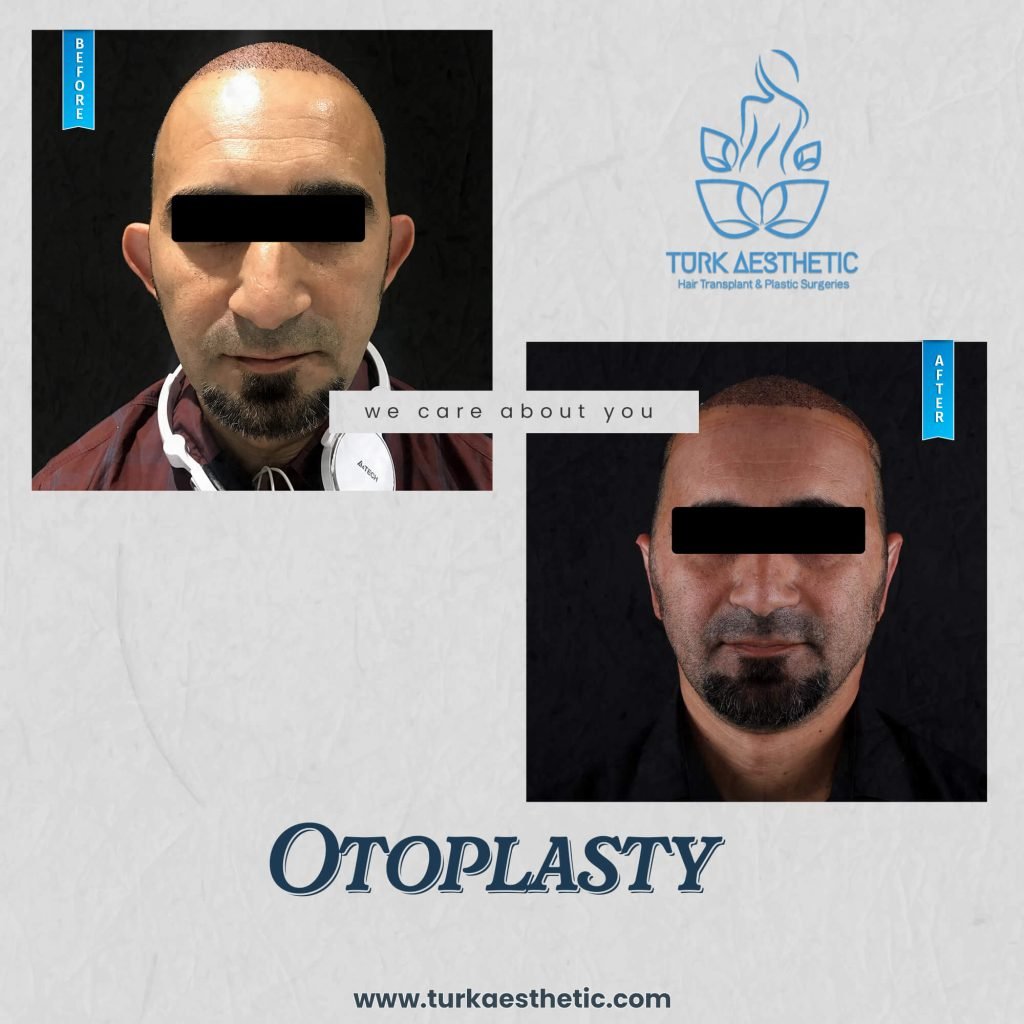
Otoplasty Post-Operative Instructions
- The patient is given a bandage over the ears (sometimes) for a week to avoid friction or movement.
- Avoid getting the wound wet for two weeks to prevent affecting the surgery and results.
- Clean the wound and maintain hygiene and sterilization continuously.
- Consult a doctor for any bleeding or discharge, such as pus.
- Ensure adequate rest for the body during the recovery period.
Pros and Cons
Any cosmetic surgery aims to eliminate defects affecting any part of the body. In the case of ear cosmetic surgery, the most essential advantage is boosting the person’s self-confidence. Additionally, when performed on children, the ear can heal faster than adults due to the flexibility of their cartilage.
As for the disadvantages, it can be noted that ears may require more than one surgery in complex cases with no external ear pinna, making the procedure more costly than in uncomplicated cases.
Side Effects of otoplasty
Like any surgery, ear cosmetic surgery is accompanied by temporary side effects that disappear after recovery. The side effects associated with ear cosmetic surgery usually include:
- Mild pain and numbness.
- Itching as a result of the surgical procedure.
- Minor bruising and slight swelling.
- In some cases, irritation and inflammation of the cartilage forming the ear due to sensitivity or weather factors. This condition is infrequent.
Otoplasty in Turkey Istanbul
Turkey is considered an ideal country for performing ear surgeries, as Turkish surgeons have extensive experience and skill in this field. In Turkey, cosmetic and medical clinics and hospitals use the latest devices, techniques, and equipment. Additionally, the healthcare sector in Turkey is characterized by effective government oversight that prevents many unprofessional and unlicensed practices in hospitals and cosmetic medical clinics. The goal of cosmetic ear surgery is to correct prominent ears, huge ears, or oddly shaped ears that affect the patient’s appearance. Otoplasty is considered very safe, and its complications are rare.
Otoplasty Cost
The cost of cosmetic ear surgery is moderate and acceptable due to the numerous specialized clinics and available options. This is one of the main attractions for undergoing cosmetic surgeries in Istanbul, in addition to the offers and discounts provided by Turk Aesthetic, which offers prices starting from 1500 euros for simple and moderate cases under local anesthesia, up to 2000 euros for cases under general anesthesia, and more than 2000 euros for complex cases.
You can contact the Turk Aesthetic team, send photos of your case, and inquire about the cost.
FAQ – Otoplasty
Does hearing get affected after cosmetic ear surgery?
Hearing remains the same because the surgery is performed on the outer part of the ear, not the inner part, so hearing is not affected at all.
When do the scars disappear after the surgery?
The incision made behind the ear during the procedure is tiny and not noticeable. Due to its location behind the ear, no one can notice that you have undergone the surgery.
When do the results of ear cosmetic surgery appear, and are they permanent?
The results appear immediately and are permanent for the rest of your life.
How long does Otoplasty take?
Ear cosmetic surgery takes approximately 1-2 hours on average.
How much does ear cosmetic surgery cost in Turkey?
At Turk Aesthetic, the cost of ear cosmetic surgery is 1500 euros and can reach up to 2000 euros in some cases.
Finally, for more information and to request prices from Turk Aesthetic, you can click the link.

